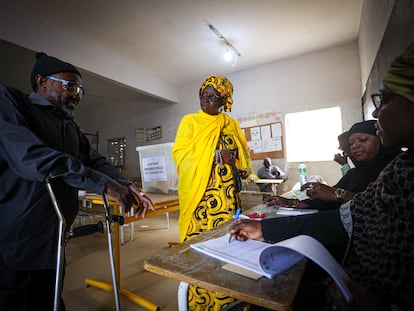How do elections work in the United States? A simple guide
Elections involve a complex process that takes more than a year, from the time aspiring candidates seek support, to the inauguration of the new president
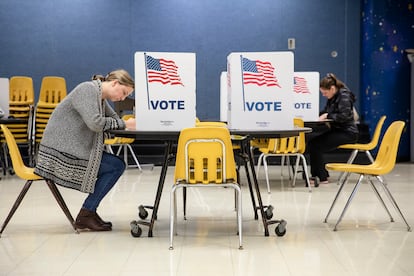
The electoral process in the United States differs from that of other democratic countries mainly because the popular vote does not define the winner of the election, but rather a group of electors chooses the president after considering the votes of the citizens. This may cause confusion for both American citizens and foreigners, but the process has been carried out in a similar manner since independence, with some changes throughout its history.
The presidential election cycle begins in the spring of the year prior to the election itself. During this period, aspiring candidates must register with the Federal Election Commission to run for the presidency. After they announce their candidacies, in the summer prior to the election, primary election debates and caucuses are held between January and June. From July to September, the conventions of each party are organized to choose their presidential candidates, who in September and October usually face each other in presidential debates. Finally, November is election day, while in December the Electoral College submits its votes for president, which are counted by Congress in January of the following year. The inauguration of the new president takes place on January 20.
Below is the detailed step-by-step process.
Start of the electoral cycle
Individuals seeking the presidential nomination must meet the following requirements: They must be a U.S.-born citizen, be at least 35 years of age and have been a resident of the country for 14 years. Likewise, they must raise more than $5,000 for their campaign in order to register with the Federal Election Commission, where they must also appoint a campaign committee in charge of raising and spending campaign funds.
Once the registration is ready, they can begin campaigning. For the 2024 presidential election, this process took place in the spring of 2023.
Primaries and caucuses
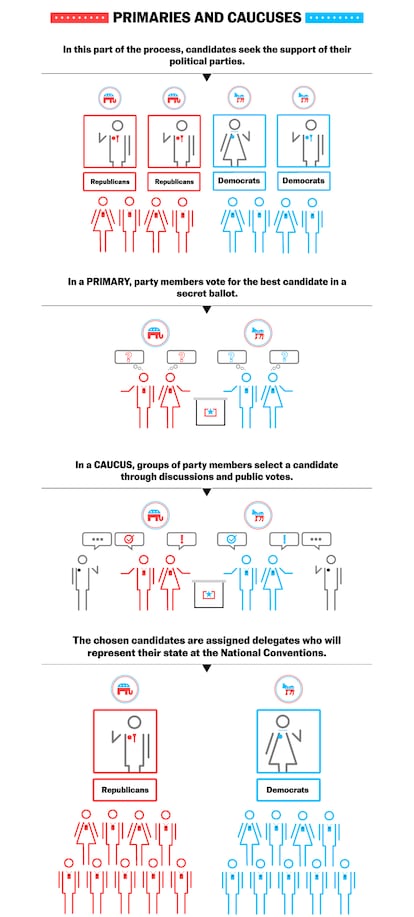
Primaries and caucuses are the next step in which states and political parties choose their presidential candidates.
- Primaries: Voters cast their preferences anonymously in a secret ballot. The results determine how many delegates are allocated to each candidate.
- Caucus: Meetings are held among members of each party where participants may vote secretly or divide into groups according to the candidate they support. The number of delegates allocated is based on the votes received at these meetings.
Primaries and caucuses may be open, closed, or combinations of both, depending on state and party rules. Under state-specific rules, delegates assigned to each candidate represent their state at the national conventions where the party’s presidential nominee is officially chosen.
The primary and caucus process for the 2024 election was held in the spring of this year.
National Conventions
National conventions are organized by political parties to officially select their presidential and vice-presidential candidates.
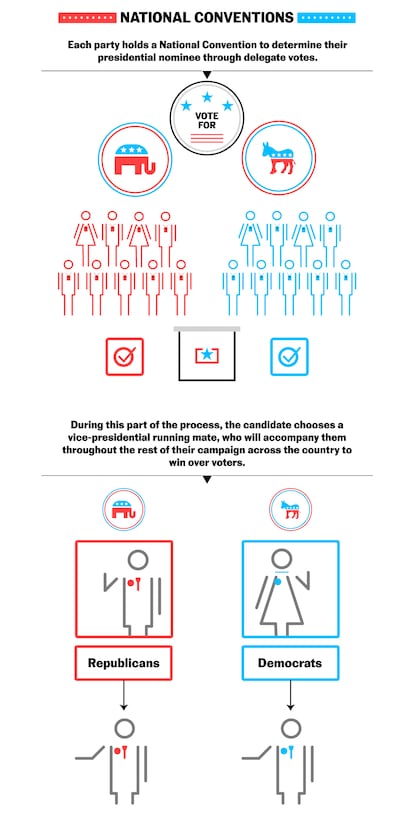
Candidates normally secure the nomination by winning a majority of delegates through state primaries and caucuses. At the convention, state delegates vote to confirm their candidate. If no candidate has a majority, additional rounds of voting are held until a nominee is chosen.
For the 2024 election, the Republican Convention was held July 15-July 18, 2024. The Democratic Convention is being held from August 19-August 22, 2024.
Types of Delegates
- Committed (or bound) delegates must vote for the candidate to whom they were assigned during the primary or caucus.
- Unpledged delegates (superdelegates) may vote for any candidate. A superdelegate is elected as a delegate to nominate at a convention because of his or her status as a leader or officer within the party.
Contentious and Negotiated Conventions
If no candidate has a majority of the delegates at the start of the convention, it is considered “contested” and delegates vote to elect a nominee.
If the first round does not result in a winner, the convention becomes “negotiated,” which allows pledged delegates to vote for any candidate in subsequent rounds, with the participation of superdelegates, until the required majority is reached.
Once this process is completed, the party should have its nominee along with its choice for vice president. This precedes the general election.
General elections (voting)
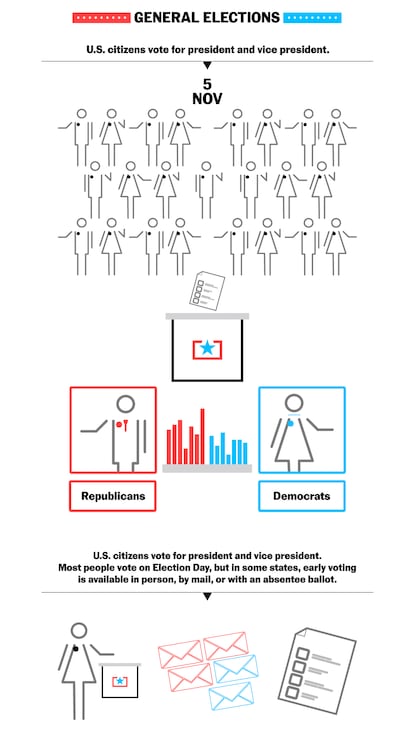
The general election is when citizens of each state in the country vote for a president and vice president from the political party of their choice. Although most people vote on Election Day, which is the first Tuesday in November, you can vote earlier in person at your state or local election office. Also, in some states, you can vote by mail by mailing in a ballot provided by the state. Each state has a different period for this type of voting.
All voters must register and obtain a voter registration card. The process is different in each state. It is recommended to check the official site of the local elections to register and be able to vote.
For the current presidential election, voting will be held on November 5, 2024.
Electoral College
While other public offices (such as senators and representatives) can be won based on the popular vote, in the case of the election for president and vice president, the Electoral College determines the winner of the presidential race.
This process consists of the selection of electors and the counting of the votes of those electors by Congress. Each state has the same number of electors as members of Congress (one for each member of the House of Representatives and two senators) while D.C. is assigned three electors, totaling 538 electors nationwide. Winning the election requires a majority of more than 270 electoral votes.
Some states have a larger number of electors than others because electoral votes are based on the total number of representatives each state has in Congress, and this is determined by the population of each state. Those with higher populations have a greater number of representatives. This system is designed to balance the influence each state has in presidential elections.
Therefore, after the citizens cast their vote, the electors of each state do likewise. While 48 states and Washington D.C. give all of their electoral votes to the winner of the popular vote, Maine and Nebraska allocate electors using a different system.
Although the popular vote plays a key role in the election, it is possible to win the Electoral College without having a majority of popular votes nationwide. This happened in the 2000 election and in 2016, when the Electoral College gave the victory to Donald Trump even though his rival Hilary Clinton had a majority of the popular vote.
The following specifies the number of electoral votes each state will have in the 2024 and 2028 elections.
In December, the Electoral College submits its votes and elects the new president of the United States, who — in the case of this election — will be inaugurated along with his or her vice president on January 20, 2025.
Sign up for our weekly newsletter to get more English-language news coverage from EL PAÍS USA Edition
Tu suscripción se está usando en otro dispositivo
¿Quieres añadir otro usuario a tu suscripción?
Si continúas leyendo en este dispositivo, no se podrá leer en el otro.
FlechaTu suscripción se está usando en otro dispositivo y solo puedes acceder a EL PAÍS desde un dispositivo a la vez.
Si quieres compartir tu cuenta, cambia tu suscripción a la modalidad Premium, así podrás añadir otro usuario. Cada uno accederá con su propia cuenta de email, lo que os permitirá personalizar vuestra experiencia en EL PAÍS.
¿Tienes una suscripción de empresa? Accede aquí para contratar más cuentas.
En el caso de no saber quién está usando tu cuenta, te recomendamos cambiar tu contraseña aquí.
Si decides continuar compartiendo tu cuenta, este mensaje se mostrará en tu dispositivo y en el de la otra persona que está usando tu cuenta de forma indefinida, afectando a tu experiencia de lectura. Puedes consultar aquí los términos y condiciones de la suscripción digital.


